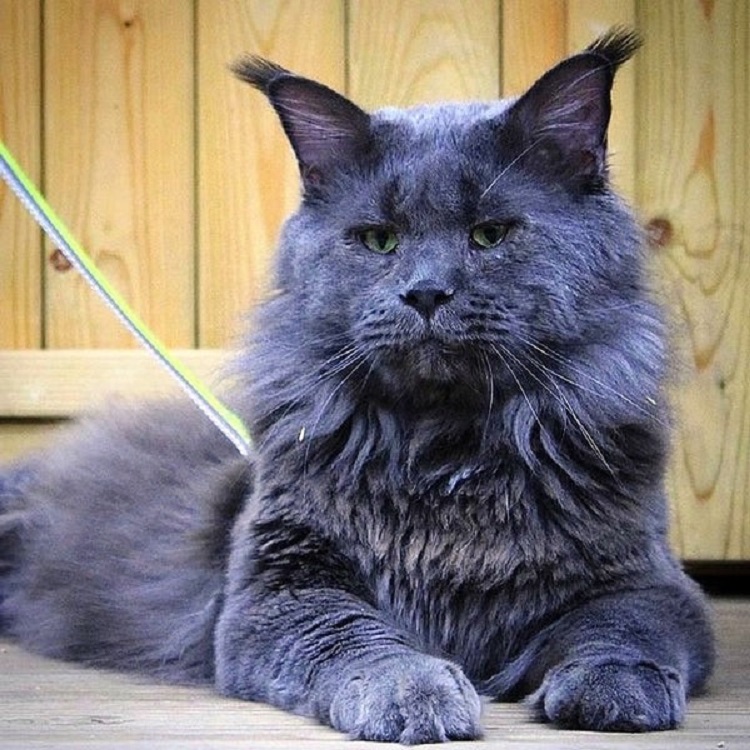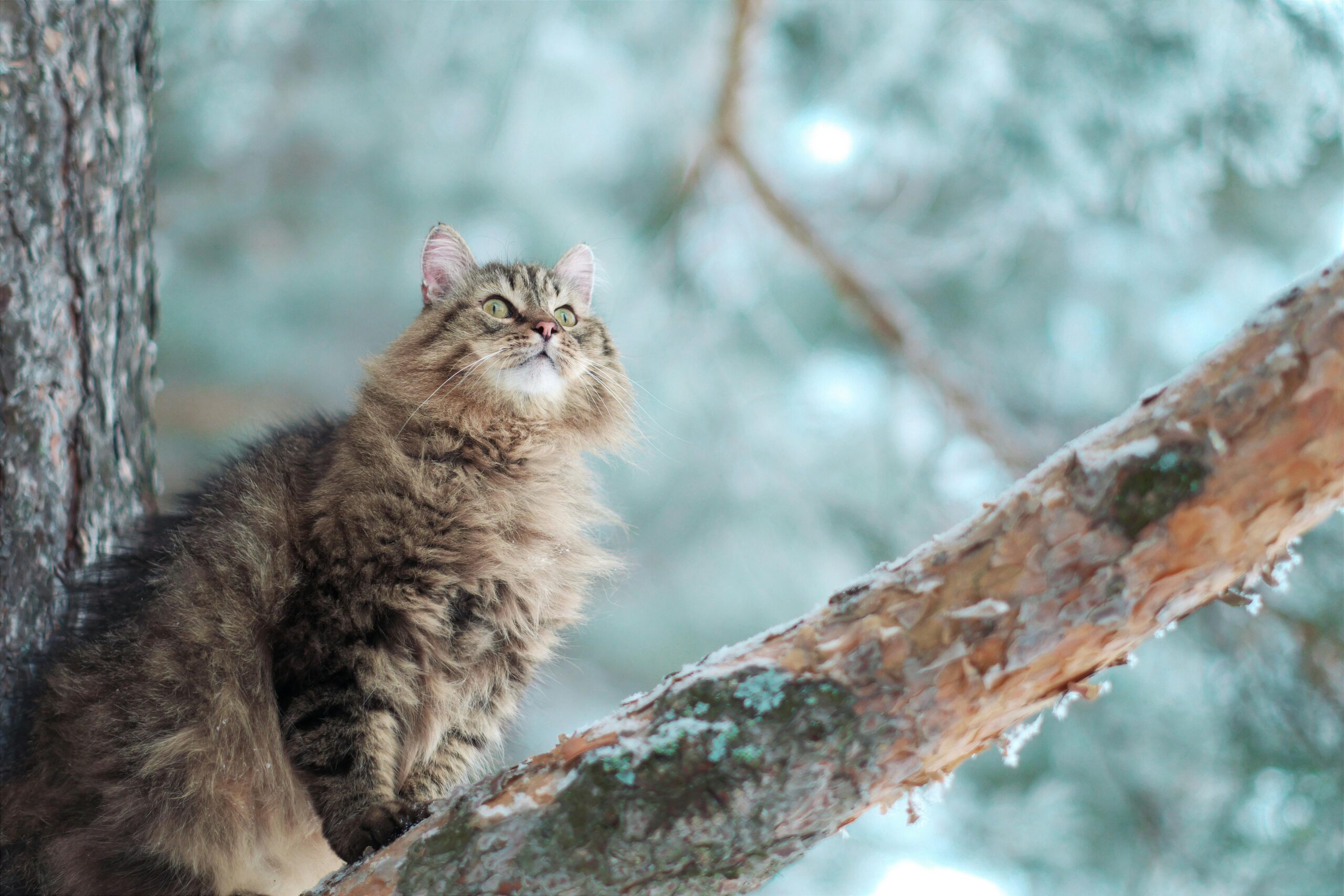Table of Contents
This blog post may contain affiliate links. As an Amazon Associate I earn from qualifying purchases.
![Hero Image for Russian Maine Coon: The Gentle Giant You Never Knew You Needed [2025 Guide]](https://wsstgprdphotosonic01.blob.core.windows.net/photosonic/ce17ec1e-78d2-4e75-b553-a98146a461e2.png?st=2025-02-09T16%3A27%3A47Z&se=2025-02-16T16%3A27%3A47Z&sp=r&sv=2025-01-05&sr=b&sig=fF4p5SN8%2Bf7ee3BGBC5CEB3NU2S3BIrwV71jX6/n%2B74%3D)
My love for Russian Maine Coons started when I first discovered how these cats bring together two amazing breeds. The story of their parent breeds fascinates me – Russian Blues sailed to Britain with sailors back in the 1860s, while Maine Coons made their British debut much later in the 1980s after developing in Northeast America.
I’ve spent years observing these beautiful hybrid cats in my home. They’re truly special – picture a cat with the Russian Blue’s gorgeous blue coat and calm personality, plus the Maine Coon’s large size and fun-loving nature. My Russian Maine Coons usually weigh between 4 to 8 kilos, and each one shows different traits from their parent breeds.
Let me share everything I’ve learned about these wonderful cats. We’ll look at what makes them unique, how to care for them properly, their health needs, and where you can find one. If you’re thinking about getting a cat or just curious about this breed, stick with me – I’ll show you why a Russian Maine Coon might be exactly what your home needs.
What is a Russian Maine Coon Cat
My Russian Maine Coons remind me of wild cats every time I look at them. Their European heritage shows clearly in their face – those high cheekbones and square muzzles give them that fascinating “feral” look [3].
Physical characteristics
I love running my fingers through their signature coat – it’s long, shaggy, and feels like silk, plus it repels water naturally [3]. The tall ears topped with lynx tips always catch visitors’ attention, and those almond-shaped eyes seem to pierce right through you [3]. My cats have shown me the amazing variety in their coat colors – from solid black and white to gray, red, and even beautiful calico and tortoiseshell patterns [3].
Personality traits
These cats truly deserve their “gentle giant” nickname. I’m constantly amazed by how smart they are – they learn tricks just like dogs! My Russian Maine Coons follow me around the house and actually respond when I call them [4]. The way they communicate makes me smile every day – they’ve got quite the vocal range, from tiny chirps to musical meows when they want to chat [4].
Size and weight expectations
You’ll need some patience with these cats – they take their time reaching their full size between three to five years of age [5]. My male cats usually hit between 18-22 pounds, while females stay lighter at 12-15 pounds [5]. When they stretch out, they can reach an impressive 38 inches, including that beautiful raccoon-like tail [5].

Size Comparison Table:
| Feature | Males | Females |
|---|---|---|
| Weight | 18-22 lbs | 12-15 lbs |
| Height | 10-16 inches | 10-16 inches |
| Length | Up to 38 inches | Up to 38 inches |
Recommended Products for Russian Maine Coon Care:
- Extra Large Cat Tree (Perfect for their size)
- Heavy-Duty Grooming Brush
- Large-Capacity Food Bowl Set
Cost and Where to Find Russian Maine Coons
Let me share what I’ve learned about the costs involved in bringing home a Russian Maine Coon. The price tag might surprise you, but it varies quite a bit depending on where you live and which breeder you choose.
Average price range
My research shows Russian Maine Coon prices really depend on your location and the kitten’s qualities. If you’re in the Western United States, expect to pay from $2,500 to $4,500 [6]. The Northeastern states tend to be a bit cheaper, with prices between $2,200 and $3,500 [6]. The South has the biggest price spread – anywhere from $2,300 to $5,000 [6].
Male kittens usually cost more than females – that’s just how the market works. You’ll need to put down a deposit first, usually $350 to $500, to hold your spot on the waiting list [7].
Finding reputable breeders
Finding the right breeder is crucial – I learned this firsthand. Here’s my guide to help you choose wisely:
Do’s and Don’ts of Breeder Selection:
| Do’s | Don’ts |
|---|---|
| Verify genetic testing documentation | Rush into decisions based on price alone |
| Request to see parent cats | Accept kittens without proper papers |
| Check breeder references | Skip visiting the cattery if possible |
| Review health guarantees | Ignore red flags about living conditions |
The good breeders I work with always provide these important documents:
- WCF pedigree certification [8]
- Complete vaccination records
- Health testing results for common genetic conditions
- Detailed care instructions
Recommended Supplies for New Russian Maine Coon Owners:
- Extra Large Cat Carrier (Amazon US/UK) – For safe transport
- Premium Grooming Kit (Amazon US/UK) – Essential for coat maintenance
- Oversized Litter Box (Amazon US/UK) – Accommodates their large size
Essential Care Guide
Taking care of my Russian Maine Coons has taught me exactly what these magnificent cats need to stay healthy and happy. Let me walk you through my daily care routine.
Grooming requirements
My cats’ gorgeous long hair needs regular attention. Their thick, double coat requires brushing at least three times per week [9]. I’ve found that a metal pin brush works best for the outer coat, while a shedding brush tackles the undercoat perfectly. Every three months, I give them a bath to keep their thick fur manageable [10].
Grooming Do’s and Don’ts:
| Do’s | Don’ts |
|---|---|
| Brush gently in short sessions | Force grooming when cat is stressed |
| Clean ears regularly | Use human shampoo |
| Trim nails monthly | Skip regular grooming sessions |
Diet and nutrition
My cats thrive on a protein-rich diet that keeps their muscles strong. I feed them a mix of wet and dry food [2]. Here’s what I make sure they get:
- High-quality protein sources
- Essential fatty acids
- Fresh water available at all times
Exercise needs
Don’t let their size fool you – my Russian Maine Coons love to play! They pick up training quickly and can’t resist interactive play sessions [10]. I’ve set up cat trees around my house and keep plenty of engaging toys to keep them active and mentally sharp.
Health monitoring
I never skip regular veterinary check-ups – they’re crucial for catching health issues early [11]. I pay special attention to their weight and heart health during these visits.
Recommended Products:
- FURminator deShedding Tool (Amazon US/UK) – Perfect for double coats
- Catit Flower Water Fountain (Amazon US/UK) – Encourages hydration
- Extra Large Cat Tree (Amazon US/UK) – Supports exercise needs
Common Health Issues and Prevention
My years with Russian Maine Coons have taught me the importance of watching for health issues. These beautiful cats can face certain genetic conditions, and I want to share what I’ve learned about keeping them healthy.
Genetic conditions
Hypertrophic Cardiomyopathy (HCM) worries me the most – it’s the number one heart problem these cats face [12]. This inherited condition makes heart walls thicken and can lead to heart failure. I’ve also seen cats with Spinal Muscular Atrophy (SMA) – it weakens their back legs [12], but with good care, they still enjoy happy lives.
My vet tells me hip dysplasia shows up in about 20% of these cats [13], causing joint pain and movement problems. We also watch for Polycystic Kidney Disease (PKD) – the cysts grow slowly and usually show up when cats are fully grown [12].
Regular vet check-ups
Once my cats turn six, I never miss their yearly check-ups [14]. During these visits, we always get:
- Heart check-ups
- Joint examinations
- Dental care
- Blood work and urine tests
Preventive care tips
Health Monitoring Do’s and Don’ts:
| Do’s | Don’ts |
|---|---|
| Schedule bi-annual check-ups | Skip regular screenings |
| Monitor weight changes | Ignore behavioral changes |
| Keep vaccination records | Delay dental care |
Recommended Health Products:
- Pet Water Fountain (Amazon US/UK) – Encourages hydration
- Joint Supplement (Amazon US/UK) – Supports hip health
- Grooming Tools (Amazon US/UK) – Maintains coat health
I keep my cats’ sodium intake low to protect their hearts [14], and make sure they get plenty of exercise for healthy joints. DNA testing has helped me spot potential problems early [12], letting me take action before issues become serious.
Final Thoughts – Russian Maine Coon
My journey with Russian Maine Coons has shown me why these cats are truly special. They’ve inherited the best qualities from both parent breeds, and I’m constantly amazed by how they combine their impressive size with gentle intelligence and loving nature.
Living with these cats takes dedication – I spend plenty of time on grooming and making sure they eat right. But every minute I invest pays off through their affection and stunning presence. My cats flourish with consistent vet care, daily exercise, and plenty of mental challenges.
Yes, the price tag of $2,500 to $5,000 might make you pause. But I’ve never regretted bringing these magnificent cats into my home. Just make sure you find a trustworthy breeder who backs up their cats with health guarantees and proper papers.
Before I brought home my first Russian Maine Coon, I made sure my house was ready. You’ll need some basics – a sturdy cat tree that can handle their size, quality grooming equipment, and proper feeding stations. These cats need space to move and play, but their gentle personality fits well in any loving home, whether you’ve got a family or live alone.
After sharing my life with several Russian Maine Coons over the years, I can tell you they’re incredible companions. I love watching them switch between playful antics and regal dignity. Their striking looks turn heads, but it’s their personalities that truly capture hearts. Each day with these cats brings new joys, and the bond just keeps growing stronger.
FAQs
How big do Russian Maine Coons typically get?
My male cats usually grow to 18-22 pounds, while my females stay smaller at 12-15 pounds. They’re impressive cats that make regular cats look tiny in comparison!What is the average lifespan of a Russian Maine Coon?
I’ve found that with good care and regular vet visits, these cats typically live 12-15 years. My oldest Russian Maine Coon reached 14 years.Do Russian Maine Coons require special grooming?
Yes, absolutely! I brush my cats at least three times every week, and they get a bath every three months. Their thick coat needs consistent attention to stay healthy and mat-free.Are Russian Maine Coons good with children?
My Russian Maine Coons have always been wonderful with kids. Their gentle, patient nature makes them perfect family pets, though I always make sure they’re properly socialized early on.How much exercise do Russian Maine Coons need?
I play with my cats every day – they love it! I’ve set up climbing spaces around the house, and we have regular play sessions to keep them healthy and happy.
References
[1] – https://sassykoonz.com/european-maine-coons/
[2] – https://www.petplan.co.uk/pet-information/cat/breed/maine-coon/
[3] – https://www.catster.com/lifestyle/european-vs-american-maine-coon-cat/
[4] – https://purebredkitties.com/blogs/maine-coon/exploring-the-majestic-maine-coon-personality-a-deeper-look-into-the-gentle-giants-of-the-cat-world?srsltid=AfmBOoqOYryUe953p6Ss0eH3_onk7GAA7C0u7kd5hy-bRjdjk0dniOji
[5] – https://en.wikipedia.org/wiki/Maine_Coon
[6] – https://spotpet.com/blog/cat-tips/how-much-does-a-maine-coon-cost
[7] – https://freedommountainmainecoons.com/maine-coon-kitten-pricing/
[8] – https://kingsize-cat.ru/en/
[9] – https://purebredkitties.com/blogs/maine-coon/maine-coon-cat-grooming-tips?srsltid=AfmBOopvzGlK2w1N0AWXUFSWb3lGMehtdLvEsWbYJoAvDPTDTuuz7B8k
[10] – https://www.whiskas.co.uk/cat-breeds/maine-coon
[11] – https://oursavvycats.com/blog/maine-coon-health-check/
[12] – https://oursavvycats.com/blog/maine-coon-health-issues/
[13] – https://drjudymorgan.com/blogs/blog/five-genetic-diseases-of-maine-coon-cats?srsltid=AfmBOorsyd-BxT4LUSaeXjQ73SWfxI7UJeQbnKts9VMpFDXyhqLuXeLZ
[14] – https://untamed.com/blogs/cat-breeds/maine-coon-health-problems

